Lumber, Labor, and the Aberdeen Black Cats
A baseball team with a connection to organized labor? Be still my political heart. Also, we didn't start the fire(s), and the underappreciated humor of Randy Johnson.
Happy Labor Day! I know most people see this as a long weekend and not much more, but I love holidays and holiday themes, so I’ve got a little something for you that fits the theme of the day: The Aberdeen Black Cats baseball team.

I first discovered the Black Cats when I was researching Seattle baseball in 1918. The Black Cats played in the Class B Pacific Coast International League alongside the Seattle Giants. I thought, “Oh, that’s cool that Aberdeen had a team.” I grew up driving through Aberdeen, a city that, if people know of it, know it as the hometown of Kurt Cobain. The Black Cats played in a very cool stadium called Electric Park:

I searched for the Aberdeen Black Cats and was taken to Ebbets Field Flannels which just happened to have a 1918 Black Cats t-shirt and home jersey. The description for the shirt mentioned that the team used the Sabo Cat logo of the Industrial Workers of the World (IWW).. The IWW is a labor union most active in the early part of the 20th century, though it still exists today. I was initially really excited to read that, then my skepticism kicked in. Baseball and labor are not friends. A team intentionally evoking a labor organization seems hard to believe. But that statement couldn’t have come out of nowhere, right? So I started digging.
The first thing I did was compare logos. The IWW Sabo Cat, or Sabo Tabby:
There doesn’t seem to be a definitive clear history of the Sabo Cat, but the story generally goes that IWW activist Ralph Chaplin created the cat because Sabo Tabby sounds like “sabotage”, if you pronounce the ‘e’. The IWW was a big promotor of sabotage, which they defined as “direct action at the point of production.”1
Compare that to the logo on the 1918 t-shirt:
It’s not the same logo, but there are similarities: the bushy upright tail, the arched back, the cat is clearly mad. This logo matches the logo on the 1909 team picture above. I only found a few pictures of teams from the early years of the team, and most of them don’t use the logo; they simply have the letter ‘A’ on their jersey. For the teams that used the logo, including the 1918 version of the team, you could certainly argue it was a stylized version of the Sabo Cat. But it still didn’t make sense to me, so I kept digging.
And that, reader, is how I discovered the Concatenated Order of the Hoo-Hoo:
The Hoo-Hoo are (they still exist!) a lumber fraternal organization founded after a logging convention in 1892. Fraternal organizations were all the rage around the time; you may have heard of the Elks, the Freemasons, the Knights of Columbus, and the Ku Klux Klan. Unlike the Klan, however, most of them dressed in their little outfits and silly hats and just hung out somewhere and didn’t do any terrorizing or lynching.
The term “hoo-hoo” was used by one of the founders to describe anything out of the ordinary or unusual. The word “concatenated” means linking things together in a series or chain. So, the Order linked together unusual things, or, people who worked in the lumber industry. The choice of the world concatenated was also intentional because, as you can see in the picture above, they chose a black cat for their mascot. The logo has the cat’s tail twisted into the number 9 to represent a cat’s nine lives. The number nine became important to the Hoo-Hoos: Nine men served on the Board of Directors, annual dues were 99 cents, meetings were held on the ninth day of the ninth month.
There were no individual clubs until 1920, but the Hoo-Hoo were everywhere the lumber industry was. When the Alaska-Yukon-Pacific Exposition was held in Seattle in 1909, the Hoo-Hoo’s built a Hoo-Hoo House, complete with large black cats.2 In 1913, Aberdeen hosted a concatenation, for new members to be initiated into the organization. Some 150 people showed up from across Western Washington to join.3
Let’s take a closer look at the Hoo-Hoo Cat:
This cat is far less aggressive than the Sabo Cat, although it shares the raised tail and arched back. This cat looks more like it’s going to pounce on some dangling yarn; the Sabo Cat looks like it’s going to rip your face off. It also looks much more like the cat logo in this undated picture, with it’s face and whiskers, and less threatening posture:
Using a black cat name to draw a connection to the Hoo-Hoo makes a lot of sense. Lumber was the major industry in Grays Harbor. The people with the money in Grays Harbor were lumber magnates. Many people in the area worked directly in the lumber industry, or were connected with it. Even in the early days, even in a smaller city like Aberdeen, running a baseball team took money. It was the lumber capitalists who had the money to run a team.
Lumber is a notoriously dangerous and deadly industry. Just flipping through newspaper pages reading about the Black Cats, it was inescapable. Stories nearly every day of men losing limbs or losing their lives. They were paid poorly and lived in temporary logging camps with pitiful conditions. Alexander Polson, who founded the Polson Logging Company with his brother, was elected to the state senate where he championed anti-labor legislation all while bragging to newspapers in 1914 about having a low payroll.4 Neil Cooney and his Grays Harbor Commercial Company sawmill in Cosmopolis were called the “Western Penitentiary” by laborers because of his notoriously low pay and terrible working conditions.
The Black Cats began playing as the Black Cats in 1907. Throwing further doubt on the idea that the Black Cats used the Sabo Cat as inspiration for their logo, the first Aberdeen chapter of the IWW was chartered in January 1910. Of course, people in Aberdeen could have IWW connections before 1910. The IWW led a mill strike in Portland in 1907 and by 1910 the IWW was active in Seattle and Spokane. But the work of the IWW in Aberdeen began in earnest in 1911.
The IWW would speak on the streets of the city, trying to convince people to join their cause, One Big Union, which would unite all of the nation’s workers so they could peacefully overthrow the capitalists who kept their wages low. Naturally, the capitalists didn’t want to be overthrown, so they fought back against the peaceful labor agitating. In August 1911, the Aberdeen City Council adopted an ordinance that limited public speaking to a two-block area away from downtown. Exceptions were made for the Salvation Army, which were working to “win souls for the Lord.”5
The IWW seized the free-speech issue and dug in. They were prevented from speaking at city council meetings, and one council member punched an IWW member at a meetings. IWW leaders in Chicago responded by telling Aberdeen’s mayor that if the ordinance wasn’t rescinded, the IWW would show their teeth.
On November 23, 1911, a crowd of 3,000 gathered to hear IWW organizer James M. Train speak in the no-speaking zone. After he was arrested for violating the ordinance, the crowd refused to disperse. The police chief ordered the fire department to set their fire hoses upon the crowd. Aberdeen Mayor James W. Parks himself helped, taking a hose into his own hands. The IWW offices were raided, IWW members were arrested, and instead of holding trials, they were packed into wagons, driven out of town, and told to never return.
The fight picked up again in 1912 when the IWW led a strike that has come to be known as “The War of Gray’s Harbor.” The strike began in March, involving thousands of mill workers and loggers from Grays Harbor and Willapa Harbor. Later, Puget Sound workers joined. Operations were shut down throughout Western Washington. City officials responded to the strike as they had to the free-speech fight, by arresting, beating, and deporting leaders. The strikes made national news, and Grays Harbor officials were praised for their extra-judicial handling of the IWW agitators.
The IWW only gained numbers and influence. Its strength peaked in 1917 when the IWW led workers across the region in what was then the largest lumber strike in US history. It was a success; the IWW won higher wages, shorter working hours, and much improved conditions in logging camps. Still, the IWW and its leaders and members were frequent targets of “patriotic” vigilantes. Nationally, the IWW was constantly targeted by government officials. Although the IWW was popular among Aberdeen’s workers, it was reviled by its city leaders and capitalists, all of whom benefited from the current economic system. They were the ones with the money and influence to run a baseball team.
It’s unlikely the Aberdeen Black Cats are truly connected to the labor movement, as much as I’d love that to be true. However, the black cat does have meaning to the lumber industry, whether through the Hoo-Hoos or the IWW, and any history of logging in Grays Harbor is also a history of labor. So there’s still a connection there in spite of itself.
When the World is on Fire, Smoke Gets In Your Eyes
A few weeks ago several large wildfires broke out near Spokane. I have family and friends out that way and it was a stressful, anxious situation to watch. So, as I do, I managed that stress and anxiety by digging into the massive wildfires that devastated the Inland Northwest in August 1910. Although the Great Fire of 1910 generally refers to the fires in Northern Idaho and Western Montana, there were fires everywhere, even in Western Washington. It was really sobering and devastating to read descriptions of fires wiping out entire towns and villages; it was exactly like reading about the fires in Maui and Spokane county this year.
I’ve only found small, uninteresting connections to baseball. It seems like they just played on in the smoke, which I guess is exactly what we do now. But in researching baseball, I’ve ran across incidental mentions of wildfire smoke looking at early 20th century newspapers. When Mark Twain visited the Pacific Northwest in 1895, the region was clogged with smoke, something he wryly noted saying, “Really your scenery is wonderful. It is out of sight.”6
As everyone who grew up here is fond of saying, “This NEVER happened when we were kids!” There are so many explanations for why we’re finding ourselves choked with smoke for weeks every summer. Climate change, drought, forest management practices. And sure, all of that contributes in some way, but I’ve wanted to really understand what’s going on. Over the weekend I read The Pyrocene by Stephen J. Pyne and, whew, it gave me a lot to ponder.
I’ve also read a lot about the response to the Great Fire of 1910, and how it changed the way we fought wildfires. I don’t understand it enough to explain it (rest assured that if I ever find a solid baseball connection with a good story, I will learn every single detail of forest fire fighting.), but it seems like this period of wild wildfires is more normal than the period where we were never driven inside for days at a time because of smoke. Which is honestly pretty depressing.
The Humor of Randy Johnson
The series the Mariners played with the Astros a couple weeks ago gave me massive flashbacks to playing the Yankees in the mid 1990s. The genuine, seething hate. The tantrums by the Yanks/’Stros. It was glorious. It brought back memories of the the Jim Leyritz-Randy Johnson confrontation in 1995 after Leyritz received a bonk on the head by a Randy Johnson fastball. Leyrtiz was pissed, and went on ESPN where he said of Randy, “He better hope he doesn’t see me out anywhere. We’ll take care of it one way or another.”7
Randy did not appreciate that. He vented to reporters, “Maybe we can do it like the 1600s, with swords or pistols at 10 paces. I can see it now, ‘High noon in Times Square.’”8
I’ve always remember that “high noon in Times Square” line, and it made me laugh hysterically at the time. Randy Johnson is remembered for being incredibly intense. But he also had a good sense of humor. He didn’t deliver it like a comedian, and it mostly came out when he was mad; he wasn’t sitting around the clubhouse cracking jokes like Ken Griffey Jr. It’s a thoroughly organic humor.
From the same incident, he talks about his relationship with Jack McDowell:
Jack screamed at me the way I screamed at Steve Howe after he hit Felix Fermin the night before. It was in the heat of the moment. I have no ill feeling toward McDowell. He didn’t send me a Christmas card and I didn’t send him one. But if he ever needs a drummer to sit in on one of his recording sessions, I’d love to.9
I imagine that after the 1995 ALDS McDowell was even less inclined to send Randy a Christmas card, much less an invitation to jam.
https://archive.iww.org/history/icons/sabotage/
https://www.historylink.org/File/8655
https://www.newspapers.com/image/71059542/?terms=%22black%20cat%22&match=1
https://www.graysharbortalk.com/2022/05/28/the-history-of-the-polson-logging-company-in-grays-harbor-county/
Hughes, John C. & Beckwith, Ryan Teague. “On the Harbor: From Black Friday to Nirvana.” Stephens Press, Las Vegas, NV (2005): 35.
Another good source of information about the labor movement in Grays Harbor is The Red Coast: Radicalism and Anti-Radicalism in Southwest Washington by Aaron Goings
Burnet, Ruth A. “Mark Twain in the Northwest, 1895.” The Pacific Northwest Quarterly 42, no. 3 (1951): 187-202. http://www.jstor.org/stable/40732736.
STREET, JIM. "YANKEE THREAT NO WORRY TO JOHNSON - M'S ACE SAYS BEANING UNINTENTIONAL." Seattle Post-Intelligencer, June 3, 1995: D1.
FINNIGAN, BOB. "MARINERS' JOHNSON STRIKES BACKRESPONDS TO YANKEE THREATS." THE SEATTLE TIMES, June 3, 1995: B1.
The News Tribune, Larry LaRue. "JOHNSON TO LEYRITZ: 'I'M EASY TO FIND'." The News Tribune, June 3, 1995: C1.

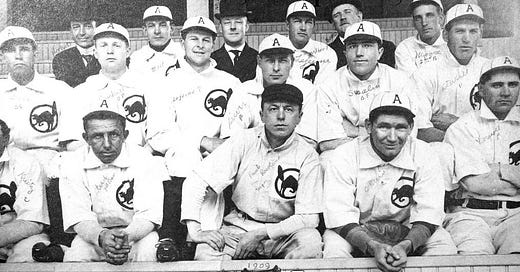

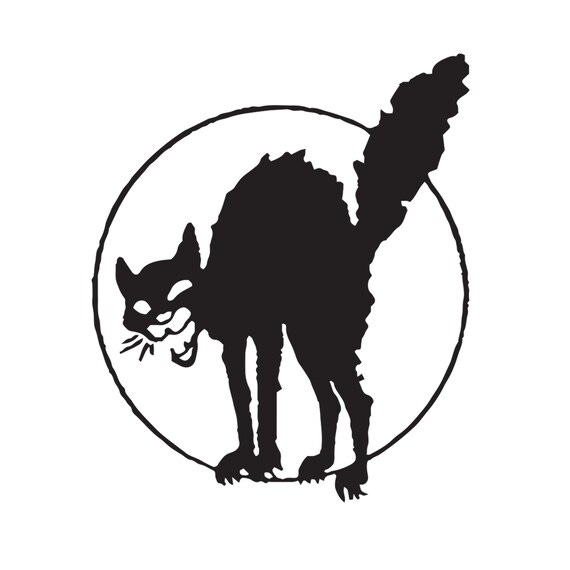
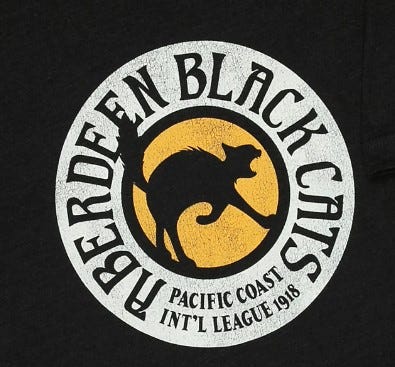
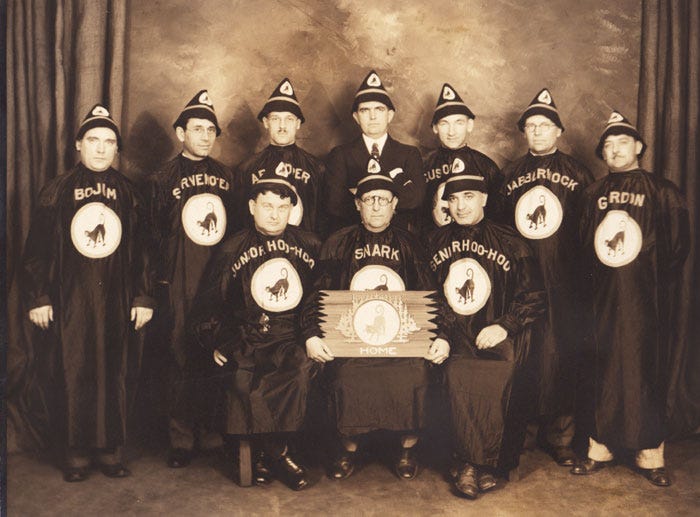


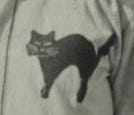
Your rabbit holes are always interesting. Thanks for chasing the black cat.
I note that '09 Cats manager (and future WS champion) Pants Rowland gets a different color cap and a cat that goes the other way.
Can we get today's MLB managers out of those silly rec-room hoodies and get them to wear slightly regrooved versions of what the players wear?
This was genuinely the strangest baseball (or I guess baseball-related) story I've ever heard. And that means a lot because this sport is so weird. Good work as always!